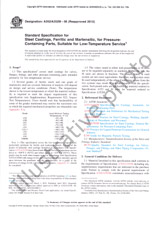We need your consent to use the individual data so that you can see information about your interests, among other things. Click "OK" to give your consent.
ASTM D1726-11(2019)
Standard Test Methods for Hydrolyzable Chloride Content of Liquid Epoxy Resins
Translate name
STANDARD published on 1.6.2019
The information about the standard:
Designation standards: ASTM D1726-11(2019)
Publication date standards: 1.6.2019
SKU: NS-951295
The number of pages: 4
Approximate weight : 12 g (0.03 lbs)
Country: American technical standard
Category: Technical standards ASTM
The category - similar standards:
Annotation of standard text ASTM D1726-11(2019) :
Keywords:
hydrolyzable chloride, liquid epoxy resin, saponifiable chloride ,, ICS Number Code 83.080.10 (Thermosetting materials)
Additional information
| Significance and Use | ||||||||||||
|
5.1 The hydrolyzable chloride content of liquid epoxy resins is an important variable in determining their reactivity and the properties of coatings made from them. These test methods may be used to determine the hydrolyzable chloride content of manufactured epoxy resins and confirm the stated hydrolyzable chloride content of purchased epoxy resins. |
||||||||||||
| 1. Scope | ||||||||||||
|
1.1 These test methods cover the determination of the easily hydrolyzable chloride content of liquid epoxy resins which are defined as the reaction product of a chlorohydrin and a di- or polyfunctional phenolic compound. Note 1: There is no known ISO equivalent to this
standard.
1.1.1 In Test Method A, the easily hydrolyzable chloride is saponified with potassium hydroxide and directly titrated with hydrochloric acid. This test method can be used for concentrations of 1 weight % and below. 1.1.2 In Test Method B, the easily hydrolyzable chloride is again saponified with potassium hydroxide, then titrated potentiometrically with silver nitrate. This test method can be used for concentrations of 5 to 2500 ppm hydrolyzable chloride. 1.2 The values stated in SI units are to be regarded as the standard. The values given in parentheses are for information only. 1.3 This standard does not purport to address all of the safety concerns, if any, associated with its use. It is the responsibility of the user of this standard to establish appropriate safety, health, and environmental practices and determine the applicability of regulatory limitations prior to use. 1.4 This international standard was developed in accordance with internationally recognized principles on standardization established in the Decision on Principles for the Development of International Standards, Guides and Recommendations issued by the World Trade Organization Technical Barriers to Trade (TBT) Committee. |
||||||||||||
| 2. Referenced Documents | ||||||||||||
|
We recommend:
Technical standards updating
Do you want to make sure you use only the valid technical standards?
We can offer you a solution which will provide you a monthly overview concerning the updating of standards which you use.
Would you like to know more? Look at this page.




 Cookies
Cookies
